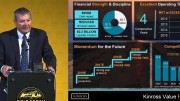Mid-February has seen a fresh wave optimism sweep through the mining industry with respect to improved operating and financial performance from the largest mining companies, including BHP Billiton, Anglo American, Rio Tinto, Vale and a host of gold majors.
It may be cold comfort for the people who have been downsized along the way, but the tough decisions taken by the super-majors in 2012 and 2013 appear to be taking hold at last, as quarterly reports come in showing lower production costs, improved earnings, more realistic capex plans and reserve estimates, and an end in sight to the brutal asset writedowns that have humiliated the industry in the world’s financial centres.
As an example, look no further than the world’s largest mining company and industry bellwether BHP Billiton. It reported a 16.1% increase in earnings before interest, taxes, depreciation and amortization to US$16.5 billion in the first half of fiscal 2014, highlighted by a 5.9% rise in earnings to US$34 billion and an 82% jump in attributable profit to US$8.1 billion.
BHP Billiton says the turnaround is thanks to a “substantial improvement in productivity and additional volume from our low-risk, largely brownfield investment program.” It adds that “the commitment we made eighteen months ago to deliver more from existing infrastructure at a lower unit cost is delivering tangible results, with annualized productivity-led volume and cost efficiencies totalling US$4.9 billion now embedded.”
With a 65% increase in net operating cash flow and a 25% reduction in cash outflows from investing activities, BHP was tallying a US$7.8-billion increase in free cash flow. On the debt side, BHP has reduced its net debt to US$25 billion, helped along by US$2.2 billion in asset sales.
Going forward, BHP says it has a target of 20% for the average rate of return for its major projects, and has expressed guarded optimism on global economic conditions, with improvements in the U.S. economy and continued growth rates above 7% in China as it transitions towards a consumption economy.
It’s hard to say how long it will take for the super-majors’ newfound capital discipline to benefit other industry participants further down the food chain, but it’s a good start.
• The ascension of a new U.S. Federal Reserve chair is greeted by gold bugs about the same way a new pope is greeted by atheists, or a new royal baby by republicans.
Early February saw Janet L. Yellen take office as Chair of the Board of Governors of the Federal Reserve System for a four-year term. She also serves as chairman of the Federal Open Market Committee, the system’s principal monetary policy-making body.
Before taken the hot seat at the Fed, Yellen served as vice-chair, having taken office in October 2010, when she began a 14-year term as a board member that will expire in January 2024.
As described in her official biography, Yellen graduated summa cum laude from Brown University with a degree in economics in 1967, and received her PhD in Economics from Yale University in 1971. She worked as an assistant professor at Harvard University until 1976, and was on the faculty of the London School of Economics and Political Science from 1978 to 1980.
Since 1980 Yellen has been a faculty member in the economics department of the University of California at Berkeley, but took leave in 1994 to serve in a string of even more impressive roles, including president and CEO of the Federal Reserve Bank of San Francisco from 2004 to 2010.
During her six-hour grilling as Fed chair before the House Committee on Financial Services on Feb. 11, Yellen confirmed that she foresees “a great deal of continuity” with Ben Bernanke’s past monetary policy, with tapering continuing at a “measured” pace. She emphasized that she supports the Fed’s dual mandate of keeping inflation low while maximizing employment, commenting that “the recovery of the labour market is far from complete.”
Investors took it as a good sign, and U.S. stocks shot up 1.1% on the day in what was quickly dubbed the “Yellen effect.” The Yellen effect looks to have made its mark on gold, too, as the metal rose and stayed above US$1,300 per oz. starting on Feb. 14.



Be the first to comment on "Editorial: Turn of the tide?"